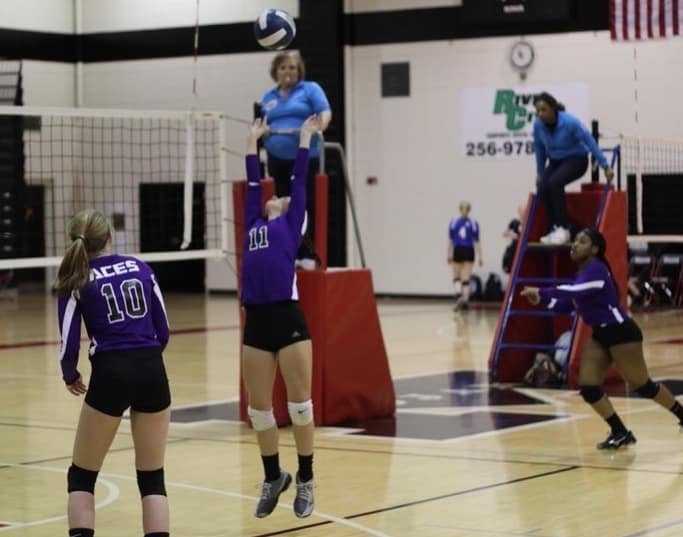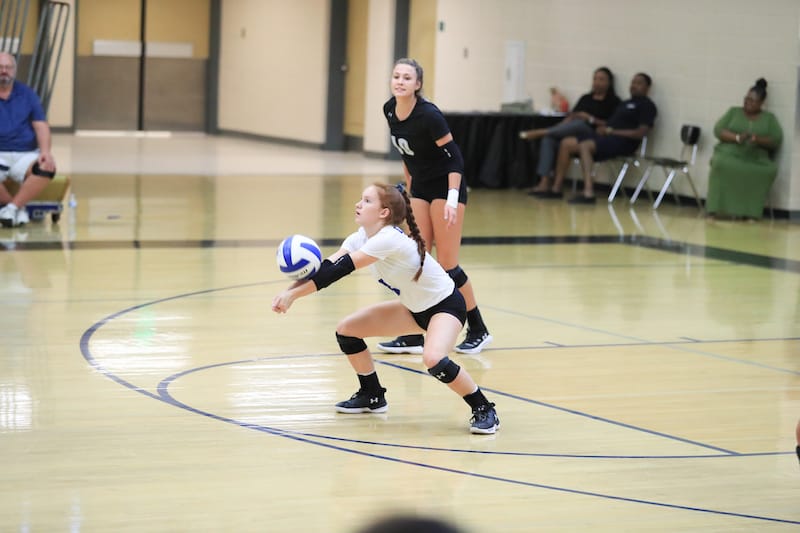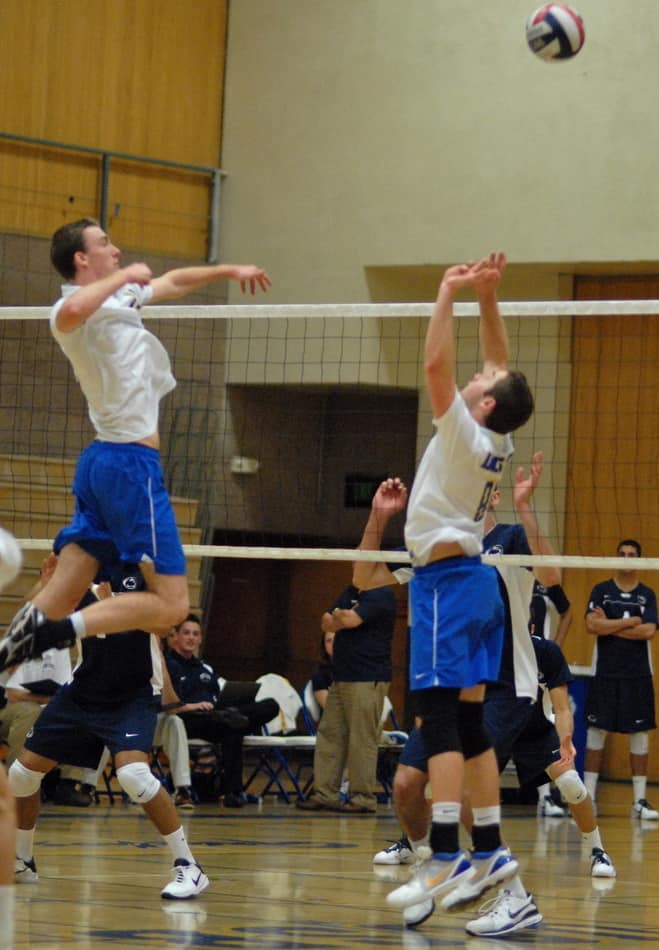Are you playing the setter position for your volleyball team and looking to improve on your skills? If you are just starting out as a setter I’m sure you want to do the very best that you can. As a setter, you will need every tool at your fingertips so that you can use the right moves in the right situations to help your offense run their attack. Back setting needs to be one of those tools!
Here are 9 tips for amazing volleyball back setting:
- Keep your hands high.
- Take the ball more directly overhead instead of at your forehead.
- Push your hips forward and arch your back slightly.
- Avoid risky sets – focus on delivering hittable balls.
- Learn to read the passer’s platform early.
- Try to deliver the ball from a balanced & neutral position.
- Master your footwork.
- Practice your technique until it becomes muscle memory.
- Do your homework – get cerebral about the game.
In volleyball, the setter position is one of the most important positions to play. While the setter is not usually drawing the most attention from the spectators, their job is making it possible for the entire offense of their team to be successful.
The setter is often referred to as being “the quarterback of the volleyball team.” That’s because the offense flows through you, you should touch the ball every time your team gets possession. A strong setter will be able to set a variety of directions, distances, and heights.
What is Back Setting in Volleyball?
A backset is used to set the ball to the player that’s attacking from behind the setter. This can be a planned play or an adjustment made during a broken play.
In a traditional situation, the setter is trying to operate from the space in between positions 2 & 3. So depending on how the ball is passed, the most likely situation requiring a backset is when you are setting the right side.
Here are 9 tips to help you develop amazing back sets:
1. Keep your hands high and keep your opponents guessing.
A large part of setting in volleyball is about being deceptive to the opposing team. If your stance, position, and follow-through become predictable, the opposing team will learn to read you and act accordingly. By always keeping your hands high, regardless of what you intend to do, you’ll keep the blockers on the other side guessing until the last second.

The more identical you can make your approach to the ball each play, the more difficult it is to read your intentions. If your “hands high” technique is consistent, you may find the opposition gives up trying to read you or they may make mistakes and guess wrong.
Another aspect of this concept is jumping when you set. If you are going to jump set some of the time, your goal should either be to jump every set or make a conscious effort to randomly mix it up and jump at some times for every variety of sets to make it impossible for them to know what’s coming. At high levels, many setters jump with every set unless they’re working with a pass that’s just too low.
2. Take the ball more directly overhead instead of at your forehead.
When you’re doing a regular set, you should be receiving the ball in front of your forehead, letting the ball come as close to your forehead as possible (without actually letting it touch of course) to gain control and be able to push with power. If you are in the right position and didn’t use your hands, the ball would bounce right into your forehead right at your hairline.
When you’re setting forward (in normal situations) you will step into the set and push the ball forward quickly. With a backset you approach the ball a little differently, letting the ball come slightly further overhead. By doing this, the ball will naturally be able to continue it’s momentum to a spot behind you.
You want to make this as subtle as possible so your opponents aren’t able to react to it. By lining the ball up just a couple inches further up into your hairline, you’re going to have a much easier time setting to the target behind you, but it won’t be noticeable ahead of time to your opponents.
3. Push your hips forward and arch your back slightly.
The difference with a backset is that you are looking to send the ball back behind you without doing a backbend. In a normal set, you’re often drastically changing the direction of the ball.
With a backset, you’re usually allowing the ball to continue in a similar general direction and with your hands creating a launching pad to guide it on the right path. With just a slight bend in your back, you will be able to carefully deliver a smooth target for your hitter.
By pushing your hips forward you can generate the needed power and avoid doing an awkward backbend. Getting comfortable with good technique takes a little patience, but will definitely pay off with this skill..
4. Avoid risky sets – focus on delivering hittable balls.
As the setter, you have to work with whatever you’re given by the passer. Unfortunately, that means a lot of the time you’re going to really be hustling to turn less-than-perfect passes into something your hitter can use. The younger the age group you’re in, or the tougher your competition is, the bigger this challenge will usually be.
To develop a strong offense, you have to give your hitters something to work with! That means using what your passers give you and trying to choose the set that’s right for the situation.
This means you may choose to back set when you didn’t plan to before because the ball was passed too far overhead. Other times you may want to go for a backset, but because the pass isn’t high enough you may have to go to plan B (your second best choice).
This doesn’t mean that you should never go for a risky set, but that you have to weigh the options in your situation. Thinking about whether your team is ahead or behind, whether you have a hitter that’s on a hot streak and who you actually have on the court at the moment, these are the kind of things you should consider when you go for risky plays.
Your role as the setter is to create a flow that allows your offense to really crank up the pressure on the other team. If you continually give your hitters well-placed balls, you’re setting your teammates up to shine. You don’t need to try to be the star player, if you do your job well, those who really understand the game will know how well you played.
5. Learn to read the passing platform early.
Highly effective setting requires you to keep your eyes on the person playing the first contact. When the ball comes over the net, whoever is playing it is going to try to pass you the ball. The surface they create with their arms is called their “platform”.

You should focus your attention on the passer and how their arms contact the ball whether it’s a serve, a freeball, or a dig. Observing this will help you to anticipate where you should be moving ahead of time. You need to learn to watch and begin moving and then track the ball as you are getting to your spot.
Have you ever noticed that some players just seem to be in the right place at the right time a lot? It’s not by accident! By thinking at a high level about the way your teammate is positioned, the angle of their arms as they create their platform, and the spacing on the floor, you can be moving to the most likely space they will be passing before your teammate even touches the ball.
To do this you really have to keep a level head and be focused. You want to play with passion and energy, but you also need to be thinking clearly, not just reacting to what happens. As soon as you read the passer’s platform, you can be deciding which attack you’re going to run with your offense.
6. Try to deliver the ball from a balanced and neutral position.
As mentioned above in tip number 1, you want to keep your approach to each set as consistent as possible to not give away information to the other team. Being consistent that way keeps them guessing until the ball is leaving your hands, making it hard for them to block and defend your attack.
The other reason you’re trying to keep your approach the same is because you want to produce consistent results. Your hitters need to be able to anticipate where the ball is going to be in time and space. They need to know how high, how far off of the net and at which second they need to get there to absolutely crush the ball.
To help your hitters be able to figure this out, your sets need to be dependable and consistent. When you’re flying all over the court, twisting, turning, and jumping off-balance, how consistently can you deliver that same set? Your goal should be: on as many plays as possible you set from a balanced, controlled and neutral stance.
7. Master your footwork.
One of the challenges in setting is being able to move through space on the court quickly and smoothly. You may dream of being able to just go stand in your position and playing some perfectly placed passes, but you’d be doing just that – dreaming! Your opponents are trying to score, so your defense is rarely going to give you those perfect rainbow passes to work with.
Working on some footwork drills can help you move more swiftly and smoothly to where you need to go. One of the main things to work on is taking large steps to where the ball is, then making minor adjustments once you’re close. You need to beat the ball there, you hope to be in the best possible spot.

Ask your coach to point out when you use bad technique. Knowing when you should be side-stepping, shuffling or using cross-over steps can make a big difference.
Practicing footwork drills is one of those skills you can do anytime, almost anywhere. You don’t need a teammate, a coach, a ball, a net, you don’t even need shoes! It may seem silly, but taking just a few minutes multiple times per day and doing a few quick steps in a particular pattern can build muscle memory and make it become so much more natural when you need it.
8. Practice your technique until it becomes muscle memory.
Back setting as a skill takes time and practice. If you want it to be a dependable weapon in your arsenal, you’re going to have to work on it consistently. Too many players only practice regular setting and then expect to be able to throw in a backset once in a while in a game and have good results. While this can work sometimes, it’s a poor way to plan on playing.
The idea of creating muscle memory is to first learn good solid technique and then practice it until it becomes permanent. I used to have a coach who would always say, “Practice doesn’t make perfect, practice makes permanent, so make sure you’re practicing perfect!” You want it to become comfortable and feel normal to do it properly.
If you’re playing at a competitive level, you should have position-specific practices. Ask your setting coach to spend a short time at each setting practice to just focus on back sets. By doing several drills in a row, you can get more comfortable and consistent at it.
9. Do your homework (this has nothing to do with school!)
Being a setter is an important and challenging role. Setters must be dedicated, focused and committed to practicing so that they have the skills to execute when the time is right. If you’re going to touch the ball on every play, you need to be confident in what you’re doing.
More than any other player on the court, the setter needs to be thinking about the game on a higher level. It’s called having a high volleyball IQ and this is something that takes work. Plan to spend time watching higher levels of competition and analyzing what they’re doing and why.
Knowing your team’s rotations and your hitter’s ability levels is a part of this. Over time you can develop a trust and understanding of which players excel in which situations and then work to create those situations.
Just being able to perform a backset is good, but really any setter can learn that. Knowing when to use it is what is really going to help you become great.
Are you new to setting, you should read through our Beginner’s Guide To Setting.
Bonus Tip For Advanced Setters
As you raise your level of ability and skill you need to find ways to avoid the expected move. As a varsity setter, you can send perfectly beautiful sets all day long, but if you’re setting in a predictable way, you may be making it nearly impossible for your hitters to hit around or through the blockers. How can you avoid this?

One way is to run what’s called a “split”. You are keeping your options open and you as the setter will make the call at the last moment as to who is getting the ball.
If the pass is poor, there’s usually an expected, standard way to play the ball. For example, let’s say your pass that comes close to the left front. A standard, good play is to set the ball just in front of you to the left-side hitter. Depending on how quickly you can get to it and where your teammates are, that may really be your only option. But your opponents know that’s the expected play. So what if you could surprise them with a solid backset to your middle hitter or even all the way to your right side? You may catch them completely off-guard and give your right-side hitter an easy shot at a kill.
Take a moment and check out 13 Volleyball Setting Tips Plus 4 Bonus Drills.
How To Tell If Your Opponent Is About To Back Set
There are really 2 things to look for that “give away” that your opponent is about to back set:
- The position of the head and trunk of the setter as they are about to begin the setting technique.
- The position of the ball at contact, in relation to their forehead.
Some of the concepts above were adapted from a study published in 2008 by the International Society of Biomechanics in Sports:
https://ojs.ub.uni-konstanz.de/cpa/article/view/1517
Photo credits:
Footwork image by Matt Pendleton on flickr.com: https://creativecommons.org/licenses/by-nd/2.0/
Men’s setting image by KLM volleyball on flickr.com: https://creativecommons.org/licenses/by-nd/2.0/
Recent Posts
Athletes, listen up! Do you have a closet full of old jerseys, sweatpants, and tees that you just can't seem to part with? Well, dust them off, because you're sitting on a goldmine of fashion...
You may have heard, or you may have noticed, that there's been a change to the rule about double contact in volleyball. In 2022, an experimental rule change began to be implemented, where the double...
